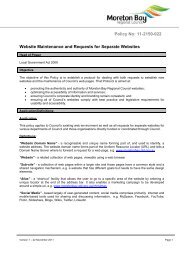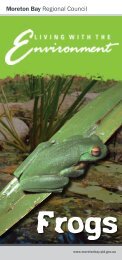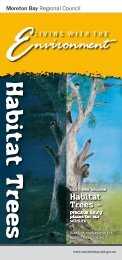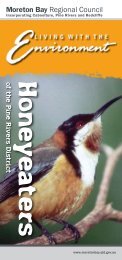10. Coastal Management Considerations - Moreton Bay Regional ...
10. Coastal Management Considerations - Moreton Bay Regional ...
10. Coastal Management Considerations - Moreton Bay Regional ...
You also want an ePaper? Increase the reach of your titles
YUMPU automatically turns print PDFs into web optimized ePapers that Google loves.
<strong>10.</strong> <strong>Coastal</strong> <strong>Management</strong> <strong>Considerations</strong><strong>10.</strong>1 IntroductionWhile consideration of options for coastal management works is beyond the scope of PhaseOne of this investigation, the following review of legislative and regulatory requirements hasbeen undertaken to frame the context in which all management options should be considered.The scope of the management options in this context has also been provided.<strong>10.</strong>2 Regulatory requirementsThe selection of the most appropriate coastal management tool at any particular location mustinclude consideration of any relevant legislation and planning requirements. As the entire studyarea is located in a region renowned for its biological diversity, the environmental protectionrequirements for the Pumicestone Passage shoreline are more complex than for many coastallocations.<strong>10.</strong>2.1 Sustainable Planning Act 2009Within Queensland, the approval of most development is regulated by the Sustainable PlanningAct 2009 (SPA). This Act establishes an integrated development assessment system (IDAS)and approval timeframes for all stages of development. To streamline the approvals process,most other development related approvals are regulated through the IDAS. In addition, the SPAalso establishes statutory plans to sustainably manage regional growth. The South EastQueensland <strong>Regional</strong> Plan 2009–2031 (SEQ <strong>Regional</strong> Plan) is the relevant plan for the studyarea. The key documents to be considered when selecting coastal management optionsresulting in development are discussed below.<strong>10.</strong>2.2 <strong>Coastal</strong> Protection and <strong>Management</strong> Act 1995The <strong>Coastal</strong> Protection and <strong>Management</strong> Act 1995 (<strong>Coastal</strong> Act) establishes criteria to allow theprotection, conservation, rehabilitation and management of the Queensland coast. Thesecriteria are also supported by State and <strong>Regional</strong> <strong>Coastal</strong> <strong>Management</strong> Plans, which set outspecific requirements for particular types of development in selected locations and have theeffect of State Planning Policies. The primary issues to be considered are:Maintenance of physical coastal processes;Conservation and protection of coastal resources;Continuance of public awareness and appreciation of coastal resources;Retention and enhancement of public access to the coast;Protection of life and property from coastal hazards (such as coastal erosion and storm tideinundation); andOngoing ecologically sustainable development of the coastal zone.The State <strong>Coastal</strong> <strong>Management</strong> Plan is currently being reviewed and a draft State <strong>Coastal</strong><strong>Management</strong> Plan has been prepared and released for public consultation. The draft plan has116 Shoreline Erosion <strong>Management</strong> Plan for Bongaree, Bellara, Banksia Beach and Sandstone Point 41/22291/11484
een significantly restructured to clarify guidance for land managers as well as for developmentassessment. Both these aspects of the draft plan are relevant to the development of this SEMPand to coastal management option selection. Until the draft State <strong>Coastal</strong> <strong>Management</strong> Planhas been approved, the State <strong>Coastal</strong> <strong>Management</strong> Plan will continue to apply. All furtherdiscussion will therefore focus on the plan currently in force.The State <strong>Coastal</strong> <strong>Management</strong> Plan and South East Queensland <strong>Regional</strong> <strong>Coastal</strong><strong>Management</strong> Plan policies of particular relevance to this SEMP are:2.1.8 Dredging – planning for coastal management should consider the impacts of dredgingto source sand for beach nourishment or otherwise, in terms of natural resources, culturalheritage values and material placement issues.2.1.9 Reclamation – land below HAT should remain in its natural state and reclaimed onlywhere necessary for erosion control or beach nourishment purposes, protectingenvironmental or other values or for operating a facility or canal.2.2.1 Adaptation to climate change – planning must address the potential impacts ofclimate change using the hierarchy of avoidance, planned retreat, accommodation, andlastly protection.2.2.2 Erosion prone areas – retain as undeveloped to the extent practicable. In areasunder constant erosion threat, planned retreat is preferred. Property protection works areconsidered to be a last resort where erosion presents an immediate threat to public safety orproperty and infrastructure that is not expendable or if retreat is impractical. The propertyprotection works are to be designed to avoid any significant adverse impacts.Erosion Prone Areas for the study area are generally 40m landward of MHWS or 10mabove revetment structures where they exist (refer to the Erosion Prone Area map inAppendix B). The base of Bribie Island is mapped with an Erosion Prone Area of 400 m.The regional plan specifically seeks to avoid property protection works such as revetmentsand boulder walls, only supporting these works where:a) there is an immediate or critical threat of loss or damage to existing development fromerosion impacts;b) no viable alternatives such as revegetation or bank reconstruction have beendemonstrated to provide a similar or adequate level of protection from erosion; andc) potential adverse impacts on coastal processes and scenic amenity are minimisedthrough remedial actions, such as beach nourishment to restore the beach andminimise impacts on adjacent coast.2.2.3 Shoreline erosion management – the preparation of shoreline erosion managementplans for all priority erosion management is strongly encouraged. Within these areas,preference should be given to coastal management options that maintain natural coastalprocesses and visual and recreational amenity. Where erosion control structures such asseawalls and groynes are considered necessary as part of a shoreline erosion managementplan, beach nourishment, revegetation or similar actions are to be investigated to mitigateany adverse impacts on the adjacent coast. The regional plan specifically identifies the41/22291/11484 Shoreline Erosion <strong>Management</strong> Plan for Bongaree, Bellara, Banksia Beach and Sandstone Point117
Sylvan Beach to Banksia Beach foreshore within the current study area as a priority area forplan preparation.2.2.5 Beach protection structures – will only be approved where there is a demonstratedpublic need and a comprehensive investigation has demonstrated no significant adverseimpacts on the longshore transport of sediments and no localised increase in coastalhazards.2.4.6 Acid sulfate soils – potential impacts to acid sulfate soils should be addressed inaccordance with the State Planning Policy 2/02: Planning and Managing DevelopmentInvolving Acid Sulfate Soils.2.4.7 Algal blooms – the entire study area has been classified as having a high indicativenutrient export potential for nuisance algal blooms. In addition, the Sandstone Point areahas been the site of a recorded outbreak of the cyanobacterium Lyngbya majuscula(Lyngbya), which poses a significant threat to human health, biodiversity, water quality andthe recreational and commercial values of coastal waterways. Appropriate management, inparticular best practice water quality management, of the study area in accordance withstrategies such as the Lyngbya <strong>Management</strong> Strategy 2002 and the Queensland HarmfulAlgal Bloom Response Plan is required to minimise the occurrence of harmful algal blooms.The principles and objectives of the draft State Planning Policy Healthy Waterways shouldbe considered in management of the Pumicestone Passage waterways.2.5.1 Indigenous Traditional Owners cultural resources – consideration of sites anditems of cultural heritage significance should be protected as per the Aboriginal CulturalHeritage Act 2003.2.6.2 Cultural heritage – places of European and Indigenous significance should beidentified, conserved and managed in accordance with the Queensland Heritage Act 1992and Aboriginal Cultural Heritage Act 2003, including Turner’s Camp memorial site.2.8.1 Areas of state significance (natural resources); 2.8.2 <strong>Coastal</strong> wetlands – theentire study area is classified as a State significant coastal wetland. In particular, anydevelopment in the area should be compatible with the protection, maintenance andenhancement of the area’s coastal resources and values and maintain and protect thecurrent extent and diversity of significant coastal wetlands.2.8.3 Biodiversity – to be conserved and appropriately managed to maintain the diverserange of habitats such as seagrass, benthic communities, dune systems, saltflats, coastalwetlands and riparian vegetation. In particular, development and activities are to avoid orminimise (in order of preference) disturbance to shorebird habitat, including nesting,roosting and feeding sites.2.8.4 Rehabilitation of coastal resources – priority for the rehabilitation and enhancementof coastal resources and values is to be given to the rehabilitation of dunes at Buckley’sHole. General areas for priority rehabilitation and enhancement comprise:– re-establishment and maintenance of vegetation along the Pumicestone Passageforeshore;– habitat corridors, and foreshore and riparian vegetation (policy 2.8.3);118 Shoreline Erosion <strong>Management</strong> Plan for Bongaree, Bellara, Banksia Beach and Sandstone Point 41/22291/11484
– shorebird nesting, roosting and feeding sites (policy 2.8.3);– coastal wetlands (policies 2.8.1 and 2.8.2); and– indicative nutrient export areas rated high to very high, particularly riparian areas (policy2.4.7).2.9.3 State land on the coast – land on the coast (including land under water) is to berecognised as having importance in decision-making for achieving coastal managementoutcomes.2.<strong>10.</strong>2 Inter-agency coordination – State agencies (as well as local and Commonwealthstakeholders) should approach the collation and exchange of information in a coordinatedmanner.<strong>Coastal</strong> development is managed and made assessable through <strong>Coastal</strong> <strong>Management</strong> Districts,which cover all tidal waters and most adjacent land (refer to the Pumicestone South <strong>Coastal</strong><strong>Management</strong> District map in Appendix B). The <strong>Coastal</strong> Act regulates tidal works through theSPA and the IDAS approval process.<strong>10.</strong>2.3 Other Queensland legislationThe Marine Parks Act 2004 provides for the conservation of the marine environment. This isachieved through the declaration of marine parks through the Marine Parks (Declaration)Regulation 2006, the establishment of zones within these, and the coordinated management ofthese parks. The Marine Park Regulation 2006 and the subordinate legislation Marine Parks(<strong>Moreton</strong> <strong>Bay</strong>) Zoning Plan 2008 establishes zones and states the objectives and activities ineach zone that are either allowed, prohibited, or require a permit. Zones that have beennominated in <strong>Moreton</strong> <strong>Bay</strong> include the general use, habitat protection, conservation park andmarine national park zones (refer to the zoning map in Appendix B). Pumicestone Channel isdominated by the conservation park zone, which restricts the intensity of fishing and crabbing,and prohibits netting, trawling and coral collecting. Activities that are consistent with theobjectives of the zone can be carried out with permission. The western shoreline of BribieIsland that is within the SEMP study area from Bongaree to Wrights Creek is zoned for habitatprotection, which allows most fishing activities but restricts trawling and coral collecting.Permission is required within a habitat protection zone for carrying out works where they areconsistent with the objectives for the zone.The Fisheries Act 1994 establishes assessment criteria relating to fisheries matters, such as fordevelopment occurring within declared Fish Habitat Areas and the disturbance of marine plants.The Buckley’s Hole area is contained within the Pumicestone Channel declared Fish HabitatArea (management level B) and the Turner’s Camp area is adjacent to the declared FishHabitat Area on the western side of the channel.The Environmental Protection Act 1994 sets out key considerations for dredging work. Thereare also additional dredging policies under the State and <strong>Regional</strong> <strong>Coastal</strong> <strong>Management</strong> Plansthat will need to be considered.The Vegetation <strong>Management</strong> Act 1999 applies to the clearing of certain native remnant andregrowth vegetation. Official mapping from the Department of Environment and Resource<strong>Management</strong> is available to identify vegetation on land regulated under the Act.41/22291/11484 Shoreline Erosion <strong>Management</strong> Plan for Bongaree, Bellara, Banksia Beach and Sandstone Point119
Permission from the State government under the Land Act 1994 is required to undertake anydevelopment on land owned by the State, and is usually required as part of making anyapplications under the SPA. The tenure of most intertidal areas is Unallocated State Land.The Nature Conservation Act 1992 and associated regulations provide for the protection,conservation and or management of natural areas relating to certain flora and fauna species.Each species listed in the relevant regulation is assigned a level of protection or management,such as rare, threatened or prohibited. The Buckley’s Hole Conservation Park at the southernend of the study area is a declared protected area. Several significant species listed in therelevant Regulation are known to inhabit the study area. The Act also allows for the preparationof conservation plans and management plans to guide protection and management of naturalareas. Clearing permits would be required for the disturbance of any ’least concern’ (or higherstatus) plant species listed under Schedule 6 of the Regulation.Consideration of Aboriginal cultural heritage must also be incorporated into the planning of anycoastal protection works. The Aboriginal Cultural Heritage Act 2003 provides guidance onensuring that activities do not harm Aboriginal cultural heritage.Notification of traditional owners about proposed works is also required under the Native Title(Queensland) Act 1993 and the Commonwealth Native Title Act 1993 where they are proposedon Unallocated State Land. A midden, bora ring and fish trap are known to be present within theimmediate vicinity of the study area.<strong>10.</strong>2.4 Commonwealth legislationThe protection and management of nationally and internationally important flora, fauna,ecological communities and heritage places is regulated under the Commonwealth EnvironmentProtection and Biodiversity Conservation Act 1999 (EPBC Act).The EPBC Act applies to certain matters of national environmental significance. As at the end ofMarch 2010, the website of the Commonwealth Department of the Environment, Water,Heritage and the Arts (DEWHA) identified the following known matters of environmentalsignificance for the study area:wetlands of international significance (Ramsar sites) – one (<strong>Moreton</strong> <strong>Bay</strong>);threatened species – 37 (includes birds, frogs, mammals, reptiles, sharks and plants); andmigratory species – 62 (includes birds, mammals, reptiles and sharks).Given the environmental sensitivity of the area, the selection and design of any coastalmanagement options will need to minimise any adverse impacts on the wetlands and speciesidentified above.Approvals under the EPBC Act can be processed alongside Queensland government approvalsin certain circumstances, however in this instance, given the scale of this project it is more likelythat a separate application will need to be made to the DEWHA for any works with potential toimpact on matters of national environmental significance.120 Shoreline Erosion <strong>Management</strong> Plan for Bongaree, Bellara, Banksia Beach and Sandstone Point 41/22291/11484
<strong>10.</strong>2.5 Planning requirementsThe SEQ <strong>Regional</strong> Plan establishes a number of principles relevant to the selection and designof coastal protection works. The policies on sustainability require that development is toincorporate protection from natural hazards, including the impacts of climate change, whilstretaining the integrity of natural areas and protection of biodiversity values.In addition, specific policies on climate change and natural hazards require:The establishment of adaptation strategies to minimise vulnerability to storm tide and sealevel rise inundation, and coastal erosion;The establishment of adaptation strategies to minimise vulnerability to cyclones and severewinds; andDevelopment decisions to be in accordance with the Queensland <strong>Coastal</strong> Plan, includingthe range of potential sea level rises.The SEQ <strong>Regional</strong> Plan coastal management policies seek to maintain, protect and enhancethe values of the region’s coast, including the foreshore, coastal wetlands, dunes, coastalprocesses, marine ecosystems, significant coastal values and marine waters. In particular, theyrequire:<strong>Coastal</strong> development to be located, designed and managed to avoid or mitigate adverseeffects on coastal values;Development other than maritime infrastructure to avoid erosion prone areas, storm tideinundation hazard areas, and undeveloped sections of tidal waterways in accordance withthe Queensland <strong>Coastal</strong> Plan;Development on the coast or in tidal waters to maintain natural physical coastal processesor ensure that there is no increased risk of shoreline erosion to adjacent areas of coastline;Maintenance and enhancement of safe public access to the foreshore and coastal watersand ensuring public access is designed and maintained to conserve coastal resources; and<strong>Management</strong> of erosion prone areas to reduce the risk of erosion.The South East Queensland Natural Resource <strong>Management</strong> Plan includes regional targets tosupport the sustainability framework of the SEQ <strong>Regional</strong> Plan. Specific targets for the coastalzone of relevance to the study area seek to:maintain or improve the extent and condition of seagrass, coastal wetlands and mangroveecosystems and habitat for key species;maintain or enhance the condition of open coastlines; andreduce the extent and frequency of coastal algal blooms.In addition, the <strong>Moreton</strong> <strong>Bay</strong> <strong>Regional</strong> Council’s Caboolture Shire Plan contains requirementsfor development. Although it is recognised that works carried out by local government for thecommunity are not subject to the requirements of the planning scheme, consistency with theobjectives of the scheme should be achieved.Consideration must also be given to the disturbance of potential acid sulfate soils in theselection of coastal management options. State Planning Policy 2/02 – Planning and managing41/22291/11484 Shoreline Erosion <strong>Management</strong> Plan for Bongaree, Bellara, Banksia Beach and Sandstone Point121
development involving acid sulfate soils provides guidance on the management of any acidsulfate soils encountered.<strong>10.</strong>2.6 Other management toolsThe <strong>Moreton</strong> <strong>Bay</strong> Shorebird <strong>Management</strong> Strategy provides guidance on the protection of<strong>Moreton</strong> <strong>Bay</strong>'s shorebird populations, by promoting their values and managing threats to theirsurvival. The listing of <strong>Moreton</strong> <strong>Bay</strong>’s wetlands as a Ramsar site recognises its status as awetland of international significance, and shorebirds are an integral component of thisecosystem.<strong>10.</strong>3 <strong>Management</strong> Options and ActionsA range of options present themselves for the ongoing management of the various coastalprocesses within the study area. These include:1. Non-protective actions, including approaches that involve:– Do nothing;– Planned retreat; and– Controlled beach access.2. Non-structural protection options, including:– Beach nourishment;– Dune management; and– Geotextile structures.3. Structural protection options, such as:– Seawalls;– Groynes and artificial headlands; and– Offshore breakwaters and submerged reefs.It is likely that a mix of the above activities may be necessary to assist in the management ofthe coastal processes evident in the study area. Further consideration of these will be providedin Phase Two of this investigation.122 Shoreline Erosion <strong>Management</strong> Plan for Bongaree, Bellara, Banksia Beach and Sandstone Point 41/22291/11484



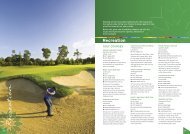
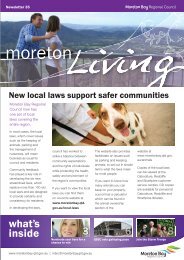
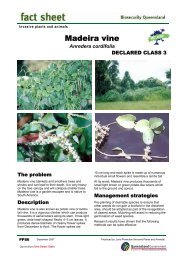
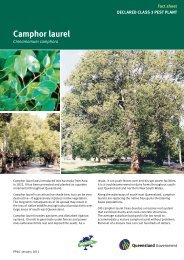

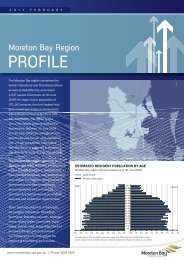
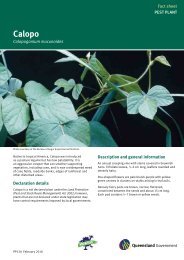

![Kumbartcho Brochure [PDF 540KB] - Moreton Bay Regional Council](https://img.yumpu.com/47220970/1/190x101/kumbartcho-brochure-pdf-540kb-moreton-bay-regional-council.jpg?quality=85)
